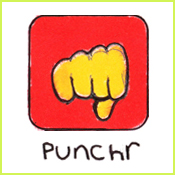Brad Hines is the president of YumDomains.com the domain name brokerage, and the founder of Hungrkids.org, a non-profit that is partnererd with the United Nations World Food Programme to raise world hunger awarness.
He is a business writer and Internet analyst, microblogging at @BradHines-He teaches how to make money on the internet.
He is the inventor of the board game Recollection as well as the Sure Shot bottle bong novelty drinking device. He sold his first web startup, Megaflow Beer Funnels at age 22.
Artistically he is an amateur fine artist and poet, and as well a professional comic artist as the creator of DimwitzComics.com. He runs a forum for artists in Montréal at McgillArt.com.
He enjoys cooking for family and friends, ice hockey and alpine snowboarding, photography, humour, design and business trends.
Registering or purchasing a domain name for your business, a comprehensive guide.
By Brad Hines | 2011-10-11
How to secure a good domain name for your business.
If you aren’t already sold that your business should have a page on the Internet, well frankly-it should. Assumingly, you are already convinced of this, as everyone around you, even the local hole-in-the-wall drycleaner has a website these days it seems. Well all websites start with a domain name, and getting a good one, and without being ripped off is a must. Here’s how:
First understand the difference between buying a domain name, and purchasing web hosting. The domain name is your address to access your website, you must get hosting to accompany it, but there is much more to be said about buying the domain name itself. Hosting is the actual space where your website is stored, and it is usually bought with the domain name, although you can certainly buy a domain name without having to get hosting. I won’t discuss hosting here.
Domain names, being very limited as there is only one of whatever name you want, suggests that you should purchase the name immediately even before you are ready to make your website, at least you will have reserved the name for yourself.
When making the decision of purchasing a domain name for your businesses website, don’t rule out the possibility of securing more then one domain name. Names can be had for cheap these days, under twenty dollars at all the major domain registrars for a yearly renewal.
Where to begin:
Start by securing the exact name of your business, preferably in .com format, and do what you can to get it-up to a point. If you are a pizza restaurant called Rick’s Pizza, surely you should check the availability of RicksPizza.com, this can be done with a WHOIS search-whois.net is good. But if someone owns it and is asking $8000 for it, you likely won’t see how to justify the price. The domain owner will be especially demanding if they are aware how badly you need the name, so if you make an offer think about how to go about this. More on this in a bit. But if getting your dream domain isn’t an option because of the price, instead you could try a different TLD-the domain ending- like RicksPizza.net, RicksPizza.biz. Dotcom is best however, so it is recommended that instead you may try adding a word to the .com version, like-OrderRicksPizza.com, etc.
Some general tips for “domain storming” a name, aim for the following:
- Try to keep your name short: names can be up to 63 characters in length, and yours should be nowhere near that.
- Be descriptive: Use relevant keywords if it makes sense, like “BuyMensPants.com” for example if you are a clothier.
- Be catchy: If you want to make up a nonsense name even, try a web 2.0 name generator like: http://www.dotomator.com. This worked for major webstart ups Joomla and Drupal for example
- Avoid trademarks in your name, as you don’t need the liability.
- Avoid hyphens in the name-unless happen to be doing business in Germany where they prefer this!
- Avoid numerical digits in the domain, this is confusing when people hear the domain name-say over the radio-and assume “5-0” was “FiveZero”
- Be sure it’s a name you don’t have to spell out for people. Flickr.com for example has had that problem since day one, spoken on the radio for example, no one knows it’s missing the “e”
- Consider misspellings: If your business is popular enough, or especially if it has a popular misspelling in the name, register different variations of how your name can be spelled. Note as a very mainstream example that googel.com links to google.com because they recognized the lost traffic they’d have received otherwise to people who cant spell "Google."
You may want to consider purchasing more then one domain to take advantage of domain forwarding-where one domain points to another. So again, if you are “Ricks Pizza”, don’t just get “RicksPizza.com” maybe get “OrderHotPizza.com” as well. People might type such terms into a search engine or even directly into the URL bar, and having those particular names forwarded to your main website would be very beneficial. Web registrars, where you register your name can certainly help you with that.
The single most important tip for securing a domain is to make sure the domain name has an auto-renewal, otherwise you can loose your domain to public auction and have to pay big to get your own name back, don’t let this happen to you by keeping your name locked at it’s registrar, and with auto-renewal set and a healthy credit card on file.Although not necessary, consider getting your domain name in other extensions as well, (TLDs as they are called) but like anything else, don’t go overboard. If you are a multinational business start up called Widget co. then by all means, purchase other ccTLDs-or Country Code Top Level Domains- such as widget.co.uk, widget.ca, widget.com.mx. There are numerous ccTLDs, many that make no sense for any one to get, and all have different rules and regulations for getting them. There is a good list of them available here: http://www.iana.org/domains/root/db
Understanding Sub-Domains and when to register additional names: If your business has major sub categories, you can get a sub domain for free typically. For example, in: this.example.com “this” is the subdomain. On a similar note, if your business is constantly making new products or services, consider registering the domain name for these things as well, and forwarding that name to the appropriate section on your main website. It would be like if McDonald’s® owned McRib.com and forwarded that to their homepage. This way you own the e-real estate on something without the risk of it being taken up by someone else.
Using domain tools to help you find a good name:DomainGroovy.com: is a great place to start as it offers the most comprehensive guide I am aware of for searching for domains like availability search, generating random words, keyword tools, brand name generators, and more
NameNinja.com: Quickly search for domains containing popular search terms. Perfect for finding your next keyword rich domain.
Dropwatch.com: Browse expiring domains by the date.
DomainsBot.com: Another good domain name generator.
Actually buying the name, when you find the one you want.
If you have done a WHOIS search, and your domain name is available, then you can be the first person to register it, otherwise you will have to buy it from someone in the secondary market. But for an available name to you to register, I recommend any of the following:
These are all large (read: good customer service), affordable, and well suited for getting web hosting with to accompany your name.
Be forewarned, when you register a domain name, it can be a confusing process, largely in part to all the up-selling the registrar will offer you (I’m looking at you GoDaddy) but the good news is, that you don’t need almost any of it. The only thing I’d recommend is that if you feel you need it, then you should purchase privacy protection. Anyone who registers a domain name has their information listed publicly in the “WHOIS” database, unless you purchase the privacy protection.
Negotiating for a name in the aftermarket:
If your name was unavailable, don’t give up hope. You can still contact the owner directly through a WHOIS search, or by searching for it on a domain name aftermarket site like YumDomains.com, Sedo.com, or GoDaddy.com. Always contact the domain owner and ask them if they domain name is for sale. Don’t under any circumstances make an offer though. The first person to name a price in a negotiation is the looser as they say.
Hide your identity if possible when negotiating to buy a domain name, as sometimes who you are can drive the price up. If Apple® needed to buy a domain name for one of their new products, you better believe they are not going to email you from their own address, they are going to get some non-descript email address to solicit you from posing as a regular Joe.
Keep in mind about domain name values, and avoiding getting ripped off: Although there are general guidelines to a domain names value, it is very subjective, and anyone selling you their domain name is likely going to command as much money as they possibly can for it, making offers you make difficult. Although a full explanation of domain valuation is beyond the scope of this article, some key valuation metrics include: domain length (the shorter the better), keywords, existing traffic-especially type-in traffic (traffic a name gets without SEO or advertising)- and even brandability.
Another good way to get a feel for domain name valuation is simply to literally examine the market for what they go for, this can be done by visiting Dnjournal.com/domainsales.htm where many aftermarket domain sales are published each week.
There is also a very comprehensive article on domain name negotiation found here: http://bit.ly/tz4bW6
Tying up some loose ends after you buy your first domain name:
It is recommended that whether or not you buy your name as an initial registration-or in the aftermarket-that you set the domain to an auto-renew as I mentioned, that the name is locked in the control panel, as names do get stolen, and lastly, that if it is a concern of yours, that you purchase privacy protection on it to protect your personal information.
Listing the name for sale after purchase:
This may seem counter intuitive, but after you make your purchase, consider putting your domain name for sale right away on a domain name broker site like YumDomains or Sedo at an enormous mark up. Even though you need the name for your business, you can list it so high that it will be worth selling it right away, and you can get a different name for your business. Always know your time outlook for your business to guide deciding such a decision, but you never know who may need your domain name so badly they are willing to pay literally ten times more than you would for it a result.
Please like, share, tweet, pin, miscellaneous-verb-here, this article if you enjoyed it! Thank you:
Other Articles You May Like:
Bonobos Pants, a case study in marketing.
How to be the next big web startup (Satire) How to Track and Grow Your Business With Pinterest
About the Author: Brad Hines is the president of YumDomains.com, the founder of HungryKids.org, and an Internet analyst. He is a writer who writes about internet and business trends. He can be followed on Twitter: @BradHines and Pinterest at: pinterest.com/bradhines. He owns several hundred domain names, and it drives him crazy.
blog comments powered by Disqus




